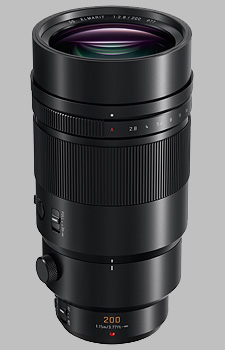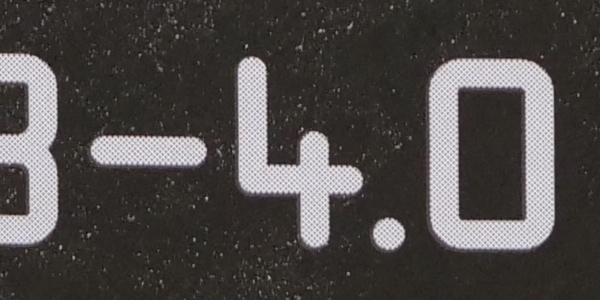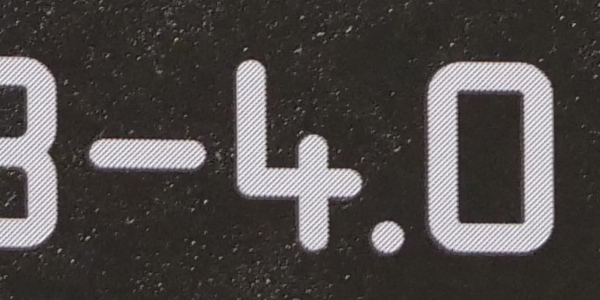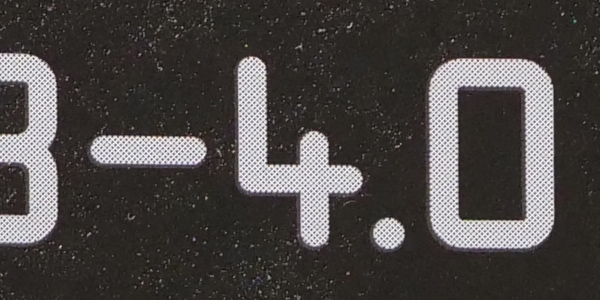| 200mm |
$2,998 average price |
|---|---|

|
|
Your purchases support this site
Buy the Panasonic 200mm f/2.8 POWER OIS LEICA DG ELMARIT
Panasonic 200mm f/2.8 Review
Updates:
11/13/2017: Hands-On & Gallery Images added
05/21/2018: Technical review added
One of the major benefits of the Micro Four Thirds system is the inherently smaller, lighter lenses that come as a result of the smaller sensor size. Small primes and zooms can be downright diminutive, but perhaps more impressive is the sizable shrinkage that can occur with super telephoto lenses -- even pro-tier, fast-aperture telephoto lenses. First, take Olympus' 300mm f/4 IS Pro lens; this 600mm-eq. is easy to hold in your hand and easily fits in a backpack, whereas Canon's 600mm f/4L IS II lens, for example, weighs 8.6lbs and is over 17 inches long.
Now, Panasonic is on the scene with their first super telephoto prime lens, the 200mm f/2.8 POWER OIS LEICA DG ELMARIT. This 400mm eq. prime lens, much like the Olympus 300mm f/4, is significantly lighter, smaller and more affordable than a DSLR equivalent 400/2.8 lens. Winner of our Best Telephoto Prime award for 2017, this as-yet-unrivaled sports- and wildlife-centric MFT lens is fantastic: sharp, well-built, and a surprisingly good value, all things considered.
Read on below for our full lab results for this pro-level Panasonic prime...
Sharpness
Unsurprisingly, the Panasonic 200mm f/2.8 is incredibly sharp, tack sharp, even at f/2.8. Across the entire frame, the sharpness graph is almost completely flat, indicating tack-sharp performance from center to corner, even when shot wide open. According to our measurements, there's an extremely minimal amount of corner softness at f/2.8, which gets sharpened if you stop down some, between f/4-f/5.6. However, despite the graphs, the difference in sharpness from the center to the corners at f/2.8 is insignificant.
From wide-open down to f/5.6, we observed optimal sharpness from the 200mm f/2.8, with tack-sharp quality across the entire frame. Once you stop down to f/8, however, slight diffraction-related softening begins to appear. It's still incredibly minor at f/8 and even still minimal at f/11. It's more pronounced once you hit f/16, which isn't surprising, though it's not terrible. At f/22, though, we definitely notice some softening.
Shutter Shock
Although our lab tests didn't indicate an issue with shutter shock, our experience with the Olympus 300mm f/4 IS Pro prompted us to quickly test to see if the 200mm f/2.8 lens experienced a similar problem. While the Olympus 300mm f/4 features fantastic image stabilization for handheld work, Olympus themselves even recommend using their cameras' Anti-Shock or Silent shooting modes for capturing images with the best detail and sharpness. Similarly, when testing the Panasonic 200mm f/2.8 with the Lumix G9 on a tripod (at the same 1/80s shutter speed used with the 300mm f/4 test and O.I.S. disabled), we observed the sharpest results with using Silent/Electronic shutter mode. The G9 offers mechanical shutter, electronic front curtain and electronic shutter (as well as an entirely "Silent" shooting mode that also uses electronic shutter). While all three shutter modes still managed to capture crisp photos, the electronic shutter mode image was noticeably crisper with better detail resolution than the other two. We didn't, however, see as severe of a difference as we did with the E-M1 II + 300mm f/4 Pro with its various shutter modes.
 |
Mechanical Shutter |
 |
Electronic Front Curtain |
 |
Electronic Shutter |
Chromatic Aberration
Chromatic aberration is very well controlled on the 200mm f/2.8, regardless of aperture setting. Both on average and at the maximum CA measured, chromatic aberration was well under three-hundredths of a percent of frame height.
Distortion
Given the telephoto focal length, it's not surprising that the Panasonic 200mm f/2.8 displays very little distortion. On average, the distortion hovers right above the 0% mark, though we do measure a very slight amount of pincushion distortion out in the corners.
Vignetting
Like CA and distortion, vignetting is hardly an issue with the 200mm f/2.8 Leica lens. Wide-open, we do still observe some slight corner shading, right around 0.25EVs of light falloff. However, vignetting quickly decreases to a nearly imperceptible level as you stop down, and in fact, past f/11, vignetting is pretty much hovering at zero.
Autofocus
Despite Panasonic cameras utilizing contrast-detect AF, the DFD technology in many of the modern Lumix cameras really boosts performance. Combine that with the 200mm f/2.8's triple linear AF motor system with a 240fps AF drive, and you have a supertelephoto lens that offers very fast and very accurate focusing performance. Despite the impressive close-focusing distance of the 200mm f/2.8, the AF speed is extremely fast, taking up to, if not less than a second to rack focus from close-focus to infinity.
Like many high-end telephoto lenses, the 200mm f/2.8 offers a focus limiting switch, which can help speed up AF performance in certain situations by limiting the range through which the lens focuses. For example, if you know you are only photographing distant subjects, you can flip the toggle switch from "Full" to the "3m-infinity" range setting that restricts the AF range to a minimum of 3m (9.8 ft) to infinity. The full range can focus as close as 1.15m (3.8 ft). In the restricted AF range setting, the lens doesn't need to adjust focus across such a vast distance, which can offer increased performance for focus adjustments.
The lens also offers a memory recall button that lets you set a custom focus distance and then quickly recall the lens back to that focusing spot at the push of a button. This is a handy feature for sports and wildlife photographers who are shooting subjects out at a specific distance and can help you avoid having the lens autofocus inadvertently to some other object between you and your subject.
Of course, manual focus is available, and the 200mm f/2.8 offers a large, wide, ribbed focusing ring. Like most Leica-branding Panasonic lenses, the build quality is fantastic, and in terms of the focusing ring itself, the ring is very smooth to rotate with a nice amount of resistance that's not too stiff yet not loose enough that you'd bump and change focus accidentally.
Macro
While the Panasonic 200mm f/2.8 is not designed for true macro photography, it has an impressively close minimum focusing distance, at just 1.15m (3.8 ft). Offering a 0.4x magnification factor in 35mm eq. terms, the Panasonic 200mm f/2.8 is quite good at macro-style close-up photography. As we saw with the Olympus 300mm f/4 Pro, which also offered similarly excellent close-focusing capabilities, the Panasonic 200mm f/2.8 far outshines the 0.16x-0.17x magnification factor of other DSLR-style 400mm lenses, such as those from Nikon and Canon.
Handling & Build Quality
As referenced earlier, Panasonic's Leica co-branded lenses tend to offer top-notch build quality, and the 200mm f/2.8 is absolutely no exception. This lens is premium through and through. Constructed almost entirely from metal, the lens feels super robust and solid in the hand. It's also understandably hefty, weighing in at 1245g (2.7 lbs), but far and away lighter than a DSLR competitor, which often come in the 8+ pound range! In addition to metal construction, the lens is also heavily weather-sealed against moisture, dust and freezing temperatures -- as expected, there's a sealing gasket around the lens mount, too.
When it comes to buttons, rings and other exterior features, the Panasonic 200mm f/2.8 has quite a few. As mentioned in the AF section above, the lens features a large focusing ring, but it also offers a manual aperture control ring, something that's rather rare for modern lenses, especially supertelephoto lenses. However, this is a typical feature of Panasonic/Leica lenses. Here, the aperture ring lets you manually set an aperture value in whole-step increments from f/2.8-f/22, or you can set it to "Auto" and adjust aperture via your camera's corresponding control dial.
As for buttons, the lens features a focus limiter switch, as mentioned, as well as the focus recall "memory" button. The memory button can also be set to a "Function" mode, which gives the user an additional programmable function button. Towards the rear of the lens, there is an AF/MF toggle switch as well as an On/Off button for image stabilization.
The 200mm f/2.8 also features a built-in tripod collar with removable tripod foot. Unlike some telephoto lenses, with fully-removable tripod collars, the Panasonic one here is fixed in place. There is a screw knob that allows the lens and camera to rotate smoothly yet freely, and there are engraved markings at the 0-degree position and +/- 90-degrees.
The Panasonic 200mm f/2.8 lens by itself is relatively compact in terms of its physical size, measuring a little under seven inches long. But it becomes noticeably larger when you add its rather sizable lens hood, itself measuring over four inches long. Like most other Panasonic/Leica lens, the barrel-shaped lens hood simply slides onto the front and secures with a small screw knob. It can be reversed and tightened in-place for storage. The hood is quite solid-feeling with thick polycarbonate plastic comprising most of the hood, while the area that fits around the lens is made of metal.
One unique feature about this lens is that it's sold with a 1.4x teleconverter -- something you definitely don't see very often unless it's one of the few super-expensive telephoto lenses with "built-in" extenders. The Panasonic 1.4x TC is very similar in size and shape to the Olympus 1.4x teleconverter, which isn't that surprising. Out of the box, then, you have a 400mm-eq. f/2.8 lens or, with the 1.4x added, a 560mm-eq. f/4 lens -- very, very handy. In a limited real-world setting, we didn't notice any degradation of image quality with the 1.4x TC attached nor any slow down of autofocus speed, which remained extremely snappy and fast.
It's worth noting that the Panasonic 1.4x TC does not fit onto Olympus lenses, such as the 300mm f/4 Pro, nor does the Olympus 1.4x TC fit onto the Panasonic 200mm f/2.8 lens. Panasonic also announced a 2x teleconverter alongside the 200mm f/2.8 -- and the 200/2.8 is currently the only lens compatible with the 2x TC. Adding this (sold separately) accessory to the 200mm f/2.8 gets you an 800mm-eq lens, but as expected takes away two stops of light, making f/5.6 your widest-available aperture.
Alternatives
At the time of this review, there isn't another direct alternative to the Panasonic 200mm f/2.8 lens -- it's the first 400mm-eq. f/2.8 telephoto prime for Micro Four Thirds. Though not the same, perhaps the most likely alternative for an MFT shooter looking for a supertelephoto lens is the Olympus 300mm f/4 IS Pro. Although offering a longer 600mm-eq focal length and a slower f/4 aperture, for sports and wildlife photographers shooting in good lighting, the Olympus 300mm and Panasonic 200mm should appeal to both camps. The image quality from the 300mm f/4 IS is fantastic, the build quality is very rugged and the image stabilization is phenomenal (especially when paired with an Olympus body). Both lenses are similarly sized and priced around the $2500 mark. However, if the light levels drop, the Panasonic 200mm f/2.8 is going to be at an advantage.
Another option would be the Panasonic 50-200mm f/2.8-4 Leica lens. Another recent addition to Panasonic's lineup, and while we've yet to lab test this lens, we have published some real-world gallery images with this lens. Image quality looks impressive, and its AF performance is excellent. The versatility of zoom might appeal to some photographers more so than the restrictions of the fixed 200mm f/2.8. Also, the 50-200mm is smaller and less expensive! The unfortunate thing is that while the 50-200mm offers an f/2.8 aperture, you'll only get this aperture at 50mm (100mm eq). At 200mm, the lens is stopped down to a maximum of f/4. This variable aperture design saves weight, but, again, in low light situations, at 200mm, the 200mm f/2.8 is at an advantage over this zoom.
Now, unless you look back towards older Four Thirds DSLR lenses, such as the Olympus 150mm f/2 or Olympus 90-250mm f/2.8 -- which are hard to come by, still expensive and will focus slower on modern Panasonic and Olympus cameras -- the Panasonic 200mm f/2.8 is the best bet for those Micro Four Thirds photographers looking for a professional-level supertelephoto prime with an f/2.8 aperture.
Conclusion
The Panasonic 200mm f/2.8 POWER OIS LEICA DG ELMARIT is a wonderful and long-awaited lens for those advanced and professional-level Micro Four Thirds shooters. Although older Four Thirds DSLRs enjoyed a handful of pro-level telephoto zooms back in the day, the newer Micro Four Thirds finally seems to be catching up with telephoto and supertelephoto offerings. As of now, the Panasonic 200mm f/2.8 is the longest and brightest supertelephoto lens available for MFT cameras. Offering a classic 400mm-eq. focal length and wide f/2.8 aperture, the lens is perfect for action, sports and wildlife, and especially so thanks to the bundled 1.4x teleconverter -- an unexpected but very welcomed little addition from Panasonic! Furthermore, the 200mm f/2.8 maintains the classic downsizing -- both in physical dimensions but also in price -- that's seen with other Micro Four Thirds lenses when compared to DSLR counterparts.
Optically, the lens is excellent, the AF performance is fantastic and the build quality is very rugged, as we should expect from a pro-level lens. Sports and wildlife fans who've downsized to Micro Four Thirds, here's your premier f/2.8 supertele lens!
• • •
Panasonic 200mm f/2.8 DG First Impressions
Taking the brightest MFT long prime out with the GH5
by Dave Pardue | Posted: 11/13/2017
I love shooting sports and wildlife, but I vastly prefer shooting handheld to being tied to a tripod. I like to shirk and jive and move whenever I need, and most of all, I like to roam, and a 400mm eq. f/2.8 lens on a full frame DSLR is not at all conducive to this. Tripods are imperative for that type shooting, but when capturing things that move I like to be moving too, and that's one of the reasons I spent so much time with the Olympus 300mm f/4 when it hit the scene in 2016. Now, Panasonic has made its big entry into the long prime sports and wildlife lens segment, and I couldn't wait to give it a shot.
The Panasonic Leica DG 200mm f/2.8 OIS on the Panasonic GH5 |
As is clearly obvious right off the bat, this model is a shorter, yet brighter, offering at 400mm eq. in 35mm terms at f/2.8, where the Olympus model is 600mm eq. and f/4. The Olympus is significantly longer, but with a full stop less light-gathering at maximum aperture. Both models intriguingly offer 6.5 stops of Dual I.S. (Sync I.S.) with capable camera bodies, and both are diminutive compared to the same animals in the DSLR/full-frame world.
Panasonic GH5 + 200mm f/2.8 shown beside the Canon 1D X II + 400mm f/2.8 |
This lens was announced the same day as the new co-flagship Panasonic G9, and because we wanted to shoot that model right away with a bevy of lenses, I loaded the 200mm f/2.8 onto the popular GH5 and headed out to see what I could find in the mid-light of November. At first I was a bit disappointed by the general autumn light level, but then it occurred to me that as someone meant to test the lens for you, this was actually good. After all, it's that generously bright aperture that's the main star of the show with this lens, and the most important factor intended to be the big difference maker compared to the competition.
1/1300s / f/3.2 / ISO 200 / 400mm eq. |
[Images have been resized to fit this page and altered in post-production, primarily to balance shadows and highlights. Click any image to see the original, unedited version as delivered by the camera. And for access to the full resolution files, RAW files and more images from this combination please see our Gallery page.]
Another important feature offered on this lens is a reported 6.5 stops of "dual" image stabilization when paired with capable camera bodies. The new Panasonic G9 is one of these, and firmware will be forthcoming in March of 2018 to bring the GH5 this capability as well. This number matches that offered by the Olympus 300mm f/4 when paired with a capable "Sync IS" body such as the E-M1 Mark II. (Note: We were unable to ascertain how many stops I.S. the 200mm f/2.8 is rated when paired with a body not capable of Dual IS. Stay tuned, as we'll report more once we get an answer from Panasonic.)
Brighter means faster
For any of you who have shot sports or wildlife at longer focal lengths, you know full well how important fast shutter speeds are. At shorter focal lengths, the wider apertures are often as much about the shallow depth of field as the light-gathering, but at longer focal lengths the depth of field is usually considerably shallow anyway, often even too shallow. It's all about light-gathering in order to use a fast enough shutter speed to freeze the action without cranking the ISO too much, and f/2.8 has long been regarded as the most classic aperture for the job.
1/500s / f/2.8 / ISO 800 / 400mm eq. |
One of the coolest things about the Leica DG 200mm f/2.8 right out of the gate is that it ships with a 1.4x teleconverter. This yields the 35mm equivalent focal length of 560mm at f/4. That's really close in focal length to the Olympus 300mm f/4, and from what I've seen thus far, the 1.4x TC offers some rather sharp imagery! We'll take a closer look at this in a section down below, but suffice it to say that you're not really trading much in comparison for focal length, given that the 1.4x ships with the lens. You are though paying about $500 more for the 200mm f/2.8, but the added versatility is built into the price.
Autofocus with the 200mm f/2.8
I found single-shot auto-focus performance between the GH5 and this lens to be superb -- both very fast and also accurate. I wasn't quite as impressed with C-AF during the soccer game I shot with this combination, as it tended to wobble a lot and also took a fairly long time to regain focus when it lost the subject. But I'd like to wait on the firmware update and shoot that type situation again before making a final decision. For now I can advise that AF-S is exceedingly fast and dependable.
1/640s / f/4 / ISO 400 / 560mm eq. (1.4x teleconverter) |
Locking in: AF-S performance between the GH5 and the 200mm f/2.8 was found to be fast and accurate. |
Going even longer
In addition to the 1.4x teleconverter that ships in the box, at announcement time Panasonic also unveiled a 2x teleconverter, which will take you all the way to 800mm eq. length, although this will decrease your light-gathering ability to f/5.6. I shot the same image with the lens and with each teleconverter for a quick reference below. The framing appears slightly different due to the difference in compression of the background at the varying focal lengths, but the focus point is close enough to the same on each image to be able to study the differences in sharpness.
Here are a few additional examples with the 2x teleconverter, and these were also all shot handheld at the maximum aperture of f/5.6
1/640s / f/5.6 / ISO 200 / 800mm eq. (2x teleconverter) |
Conclusion
I've thus far enjoyed my brief stint with the Panasonic 200mm f/2.8, and look forward to more shooting to come. It allows for a bright aperture at a fairly long focal in a package that is easily handheld for extended periods of time out in the field. The image quality thus far from this lens has proven superb, as have the images with the 560mm eq. 1.4x teleconverter engaged, and I look forward to seeing our forthcoming lab results. This lens represents mobility combined with versatility, and I personally find that combination tempting indeed. To be sure, this is a nice lens and a versatile package given the included 1.4x teleconverter.
Stay tuned, as we'll have you much more to come from the test lab and the field with the intriguing 200mm f/2.8 Lumix lens.
1/1300s / f/3.2 / ISO 200 / 400mm eq. |
1/1000s / f/3.2 / ISO 200 / 400mm eq. |
• Panasonic 200mm f/2.8 DG O.I.S. Gallery •
Panasonic 200mm f/2.8 POWER OIS LEICA DG ELMARIT
Your purchases support this site
Micro Four Thirds - Black
Panasonic 200mm f/2.8 POWER OIS LEICA DG ELMARIT User Reviews
The Panasonic 200mm f/2.8 POWER OIS LEICA DG ELMARIT doesn't have any user reviews yet!



